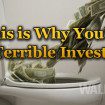Over the past 20 years, the S&P 500 has produced a 9.2% annualized total return. Over the same period, gold has returned an annualized 6.6%. And bonds? The Barclays U.S. Aggregate Bond Index has returned 5.7%. Based on these figures, what type of return do you think the average investor has achieved over this time period? The answer will shock you. [Read on!]
returned an annualized 6.6%. And bonds? The Barclays U.S. Aggregate Bond Index has returned 5.7%. Based on these figures, what type of return do you think the average investor has achieved over this time period? The answer will shock you. [Read on!]
The above introductory comments are edited excerpts from an article* by Alan Gula, CFA (wallstreetdaily.com) entitled The Main Reasons Why Investors Underperform.
The following article is presented courtesy of Lorimer Wilson, editor of www.munKNEE.com (Your Key to Making Money!), and www.FinancialArticleSummariesToday.com (A site for sore eyes and inquisitive minds) and has been edited, abridged and/or reformatted (some sub-titles and bold/italics emphases) for the sake of clarity and brevity to ensure a fast and easy read. This paragraph must be included in any article re-posting to avoid copyright infringement.
Click on Facebook for latest articles on gold/silver & economic/financial matters from munKNEE.com
Click on Twitter for latest tweets from munKNEE.com
Click here to subscribe to the FREE Market Intelligence Report newsletter (sample here)
Gula goes on to say in further edited excerpts:
Quantitative analysis from DALBAR, a financial market research firm, shows that the average investor has realized a measly 2.5% return over the past 20 years. This means the average Joe has outperformed inflation by just 0.2% per year. Told you it was shocking, right?

There’s actually a very simple reason why the average return is so dismal, though. People tend to be terrible investors because of the way our brains work. We have a plethora of behavioral biases that hinder our decision-making processes.
Behavioral Biases
Do you feel like you have a good grasp of what will happen in the financial markets – and an ability to make money based on this knowledge? Well, you’re not alone. Research suggests that most investors display overconfidence. That is, they overestimate their ability to predict market events.
Behavioral theorists, Brad Barber and Terrance Odean, conducted a study that illustrated the dangers of overconfidence. They divided clients at a large brokerage firm into groups, based on their frequency of trading. The results showed that the return for the group that traded most frequently was about 6% less than the group that traded the least.
Other biases include the bandwagon effect, which leads to herding behavior. This helps explain why there are so many “glamour” stocks with P/E ratios greater than 100x.
In addition, Daniel Kahneman and Amos Tversky’s work on loss aversion indicates that our pain from loss is more acute than our pleasure from gain.
These behavioral biases largely result from us being emotional creatures. We tend to make irrational decisions at the worst possible moments. The average investor becomes euphoric at market peaks and goes all-in. On the flipside, they panic after a significant decline, usually selling at the bottom.
The combination of cognitive biases and emotional decision-making leads to the lackluster investor performance seen in the chart above.
What Will You Do When the Market Drops Again?
An important step in overcoming these shortcomings is to have a plan.
An investment policy statement (IPS) is a written plan that includes details about your goals, risk tolerance and investment strategy. Morningstar even has a downloadable Investment Policy Worksheet (PDF form).
Everyone should draft an IPS. However, the preparation doesn’t stop there. In your mind, imagine the emotions associated with various potential outcomes. For example, think about how you’d react if each of your stocks or ETFs experienced a significant decline. Now is a great time to perform this mental exercise, considering that the S&P 500 has gone over two years without a 10% correction.
Are you prepared? What will you do when it occurs? What’s your plan of action if the correction extends beyond 10%? What if the market continues to grind higher, instead? Planning is what will separate us from average investors, who may barely outperform inflation over the next 20 years.
Editor’s Note: The author’s views and conclusions in the above article are unaltered and no personal comments have been included to maintain the integrity of the original post. Furthermore, the views, conclusions and any recommendations offered in this article are not to be construed as an endorsement of such by the editor.
*http://www.wallstreetdaily.com/2014/07/01/investor-cognitive-emotional-bias/(© 2014 Wall Street Daily, LLC. All rights reserved.)
Related Articles:
1. Its Time to Stop Trying to Time the Market & Start Playing the Percentages – Here’s Why
Remember the game Musical Chairs? It seems that investors on Wall Street have been playing this game recently, as more and more we are seeing signs that the current bull market may be reaching its final stages. Each new sign that appears represents just one more chair being taken away from the game. The question investors need to ask is “where will I be when the music stops”? Read More »
2. Bubbles: Doing NOTHING Is Often the BEST Response – Here’s Why
The benefits of being able to detect a bubble, when you are in its midst, rather than after it bursts, is that you may be able to protect yourself from its consequences. [Below are possible] mechanisms to detect bubbles, how well they work and what to do when you think a particular asset is in one. Read More »
3. Should You Replace Your Financial Advisor With A “Robo” Advisor? Here Are the Pros & Cons
In the last few years a new “advisor” has entered the fray – the robo advisor, now being called “automated investment services”. Automated investment services are platforms that automate your investment portfolio and try to help you reduce fees, increase efficiencies and streamline your process through a simple computerized interface. Here’s a look at 4 primary benefits and 4 potential problems to help you decide if such a service is for you. Read More »
4. Self-manage Your Portfolio? Think Again! Here Are 10 Reasons You NEED a Financial Advisor
Irrespective of any active v. passive investing debate, good advisors are an absolute necessity. Here’s my top 10 list of reasons why Read More »
5. How Does Your Financial Advisor Measure Up to These 20 Criteria?
 munKNEE.com Your Key to Making Money
munKNEE.com Your Key to Making Money



That is really attention-grabbing, You’re an excessively skilled blogger.
I’ve joined your rss feed and stay up for in search of more of your fantastic post.
Also, I have shared your web site in my social networks